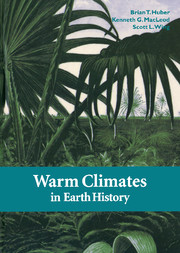Book contents
- Frontmatter
- Contents
- List of contributors
- Preface
- Part 1 Approaches to the study of paleoclimates
- Part II Case studies: latest Paleocene–early Eocene
- Part III Case studies: Mesozoic
- Part IV Case studies: Paleozoic
- 11 Permian and Triassic high latitude paleoclimates: evidence from fossil biotas
- 12 Organic carbon burial and faunal dynamics in the Appalachian Basin during the Devonian (Givetian–Famennian) greenhouse: an integrated paleoecological and biogeochemical approach
- 13 Glaciation in the early Paleozoic ‘greenhouse’: the roles of paleogeography and atmospheric CO2
- Part V Overview: climate across tectonic timescales
- Index
- Plate section
13 - Glaciation in the early Paleozoic ‘greenhouse’: the roles of paleogeography and atmospheric CO2
from Part IV - Case studies: Paleozoic
Published online by Cambridge University Press: 06 July 2010
- Frontmatter
- Contents
- List of contributors
- Preface
- Part 1 Approaches to the study of paleoclimates
- Part II Case studies: latest Paleocene–early Eocene
- Part III Case studies: Mesozoic
- Part IV Case studies: Paleozoic
- 11 Permian and Triassic high latitude paleoclimates: evidence from fossil biotas
- 12 Organic carbon burial and faunal dynamics in the Appalachian Basin during the Devonian (Givetian–Famennian) greenhouse: an integrated paleoecological and biogeochemical approach
- 13 Glaciation in the early Paleozoic ‘greenhouse’: the roles of paleogeography and atmospheric CO2
- Part V Overview: climate across tectonic timescales
- Index
- Plate section
Summary
ABSTRACT
The Late Ordovician (Hirnantian) glaciation was the only major glaciation during the generally ice-free early Paleozoic. It had a profound effect on the earth system and is closely associated with a major Phanerozoic mass extinction. This glaciation has attracted attention in recent years because geochemical models and proxy data indicate ∼14–16 times the present atmospheric level (PAL) of atmospheric CO2, apparently coincident with the glaciation. Previous climate modeling studies postulated that glaciation was possible at high CO2, given the paleogeographic configuration of the Late Ordovician. With the coast of Gondwana positioned close to the South Pole, the ocean's thermal inertia would have prevented summer temperatures from rising above freezing, thus allowing snow to survive and glacial inception. However, recent stratigraphic and stable isotope studies indicate that major glaciation lasted perhaps less than 1 million years, meaning that mechanisms operating on tectonic timescales are unlikely to be the primary cause of the glaciation. A change in oceanographic circulation which led to an increase in organic carbon burial has recently been proposed as the cause of a brief drawdown of atmospheric CO2, which resulted in the Late Ordovician glaciation.
We present new general circulation model results for both Late Ordovician and Early Silurian paleogeographies, using identical solar luminosities (a 4.5% reduction from modern) and atmospheric CO2 levels. These experiments allow us to address the relative importance of paleogeography and CO2 in forcing the development of a positive snow mass balance on Gondwana.
- Type
- Chapter
- Information
- Warm Climates in Earth History , pp. 386 - 422Publisher: Cambridge University PressPrint publication year: 1999
- 1
- Cited by



